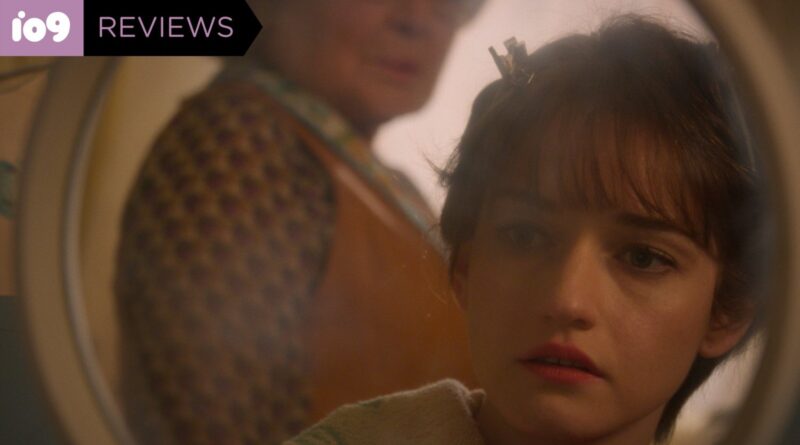Apartment 7A Brings Atmospheric Backstory to a Celebrated Horror Tale
If “prequel to a classic movie about the birth of the Antichrist” sounds like something you’ve already encountered this year, you’re not possessed: back in April, The First Omen delivered a gruesomely creative exploration of events leading into The Omen. Apartment 7A endeavors to do the same for Rosemary’s Baby, and while its story offers fewer shocks than The First Omen, it’s still a thoughtfully considered prequel anchored by an intriguing point of view.
Inspired by Ira Levin’s 1967 novel and Roman Polanski’s 1968 film, Apartment 7A was co-written and directed by Natalie Erika James, who also made 2020’s Relic—the tale of three generations of women grappling with a creepy presence in their family home. Another sinister dwelling takes center stage in Apartment 7A, and Rosemary’s Baby fans know it well: the Bramford, a once-elegant New York City apartment building whose aging walls conceal a coven of equally aging Satanic witches.
The new film’s production design pays close attention to detail, and while the setting feels authentic, it’s not aiming to exactly copy Polanski’s version. There are key elements that carry over, however, including those very thin partition walls that allow raised voices and the haunting piano notes of “Für Elise” to waft between units.

Into this towering pile of dark wood, yellow lighting, and birdcage elevators stumbles Terry Gionoffrio, a character who factors into the first 15 minutes of Rosemary’s Baby. Apartment 7A takes us back a year or so earlier; it’s 1965, and Terry is just starting a promising dance career when she suffers an agonizing injury. Julia Garner (Ozark, next year’s The Fantastic Four: First Steps) brings a vulnerability to her version of Terry. You feel her frustration as she faces not just money woes, audition rejections, and a worrisome dependence on painkillers, but also the unbearable feeling that the goals she’s been obsessively pursuing are slipping away.
In that headspace, you understand why she might make some decisions she otherwise wouldn’t, like accepting a free place to live from Minnie and Roman Castavet (Dianne Wiest and Kevin McNally—both good, but not as iconic as Rosemary’s Baby stars Ruth Gordon and Sidney Blackmer) right after meeting them for the first time. The Castavets, you see, simply adore helping troubled young women get their lives together. They’re also good friends with a Bramford resident (Jim Sturgess) who’s written a new musical that Terry would dearly love to be cast in.
We know this is all a very bad idea—after all, Terry’s fate is the reason Rosemary Woodhouse becomes Satan’s next womb of interest—but James and Garner find ways to bring emotional nuance to Terry’s increasingly bleak situation. Very much like Rosemary, she has to put the pieces together for herself in a story drenched in aggressive ambition, gaslighting, emotional abuse, sexual assault, body horror, loneliness, and the petrifying feeling of not being safe in one’s own home. But in contrast to Rosemary—a housewife cheerfully hoping to become pregnant—Terry is single, broke, unable to find work, and without any support system beyond her sympathetic best friend.

For all the callbacks to Rosemary’s Baby (most of them are obvious: the impulsive short haircut, the vodka blush cocktails, a memorable silver necklace), the new movie does make one major alteration involving the intersecting plots of the two films—it’s an intriguing choice, and one that adds a layer of separation between Terry and Rosemary’s ordeals.
But there’s also another big difference that’s less easy to put your finger on. One of the most chilling aspects of Rosemary’s Baby is that it’s not just the tale of a mom-to-be slowly realizing she’s the target of an evil conspiracy. Most of it takes place in the Bramford, but it feels bigger than that. Along with the protagonist, the viewer steadily begins to feel paranoid about the world Rosemary’s Baby takes place in. Just how many people are participants in this apocalyptic plot? Is this a global destiny of doom we cannot avoid? By the time that famous final scene rolls around, our fears are mostly proven true.
Apartment 7A feels more intimate. Terry may fantasize about having her name up in lights, but she’s more commonly known around Broadway as “the girl who fell,” a snarky reference to her devastating onstage tumble. But she’s also “the girl who fell” for the idea that complete strangers can be selfless and kind—and who realizes too late the devastating price required to bring her glittering dreams back to life.
On a final note, there’s a further similarity that links Apartment 7A and The First Omen: both were made by women, in contrast to the classic films that inspired them. So often in horror we see female characters put through their paces by male directors; these films signal a welcome change in perspective, particularly as it comes to the familiar genre trope of women’s bodies being seized and appropriated in grisly ways.

Apartment 7A streams on Paramount+ and will be available for digital purchase September 27.
Want more io9 news? Check out when to expect the latest Marvel, Star Wars, and Star Trek releases, what’s next for the DC Universe on film and TV, and everything you need to know about the future of Doctor Who.

